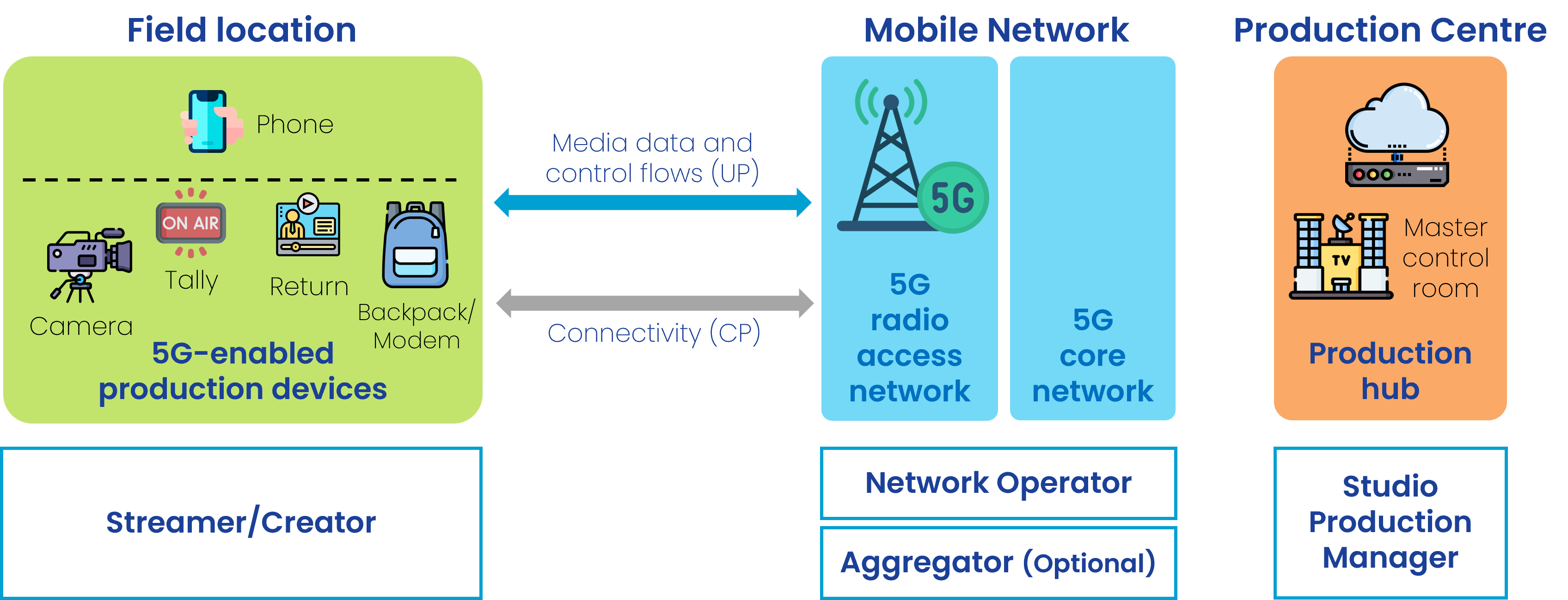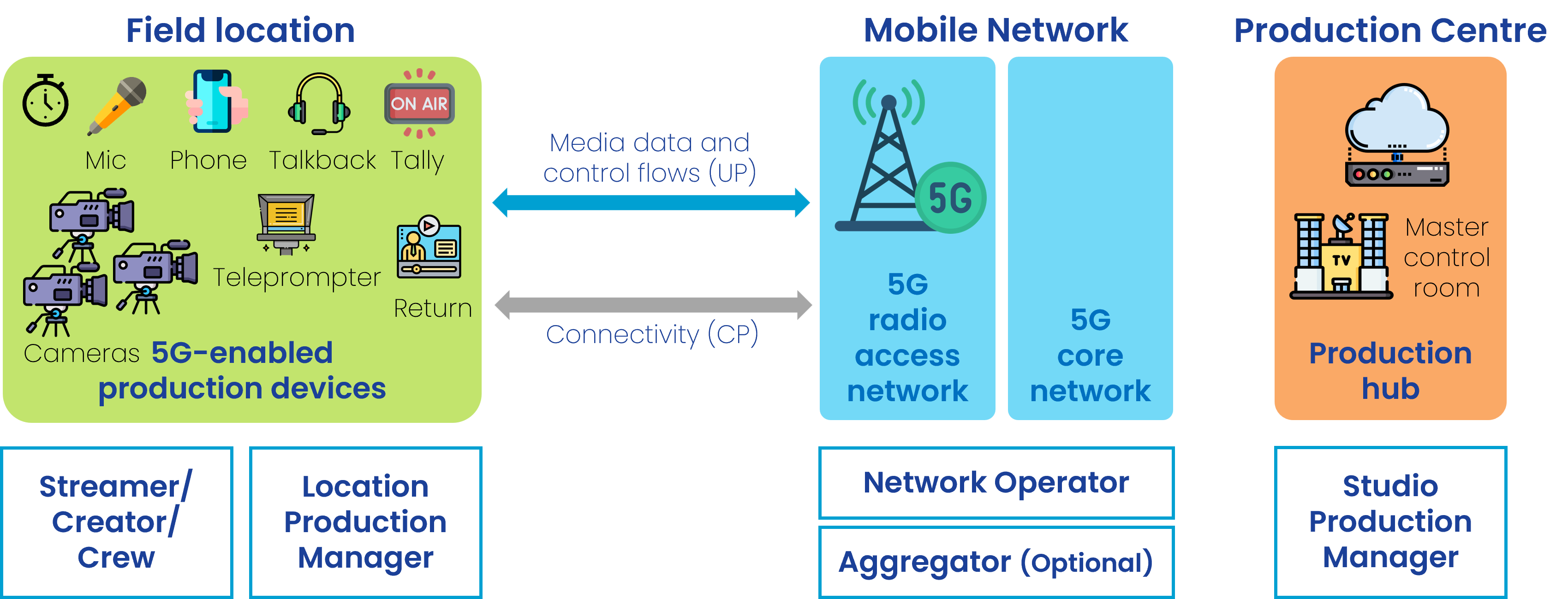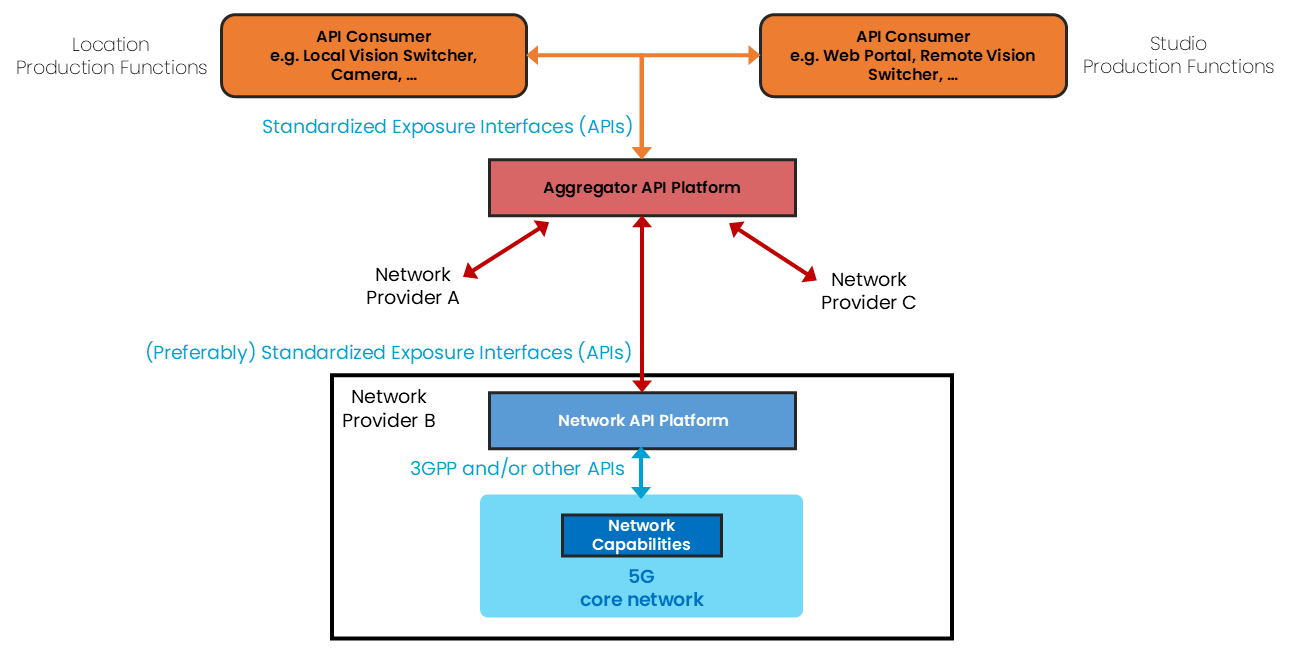This documentation is currently under development and subject to change. It reflects outcomes elaborated by 5G-MAG members as part of WI: Network Exposure and APIs Supporting Media Services and Applications We welcome and encourage contributions from the broader community. If you are interested in becoming a member of the 5G-MAG and actively participating in shaping this work, please contact the Project Office
Network Capability Exposure and APIs for Content Production and Contribution
The exposure of network capabilities to applications representes an opportunity to exploit advanced network features beyond best-effort connectivity. Examples of network capabilities maz include on-demand quality, user equipment (UE) management, precise time synchronization,… Accessing and utilizing the desired features can be intricate and inconsistent across different networks. Several initiatives are taking shape to explore the opportunities behind Network APIs (exposing network capabilities to API consumers), offering high-level abstractions of underlying network functionalities to simplify resource utilization for non-network experts.
Use cases identified in Towards a comprehensive 5G-based toolbox for live media production that may benefit from specific network capabilities beyond best-effort connectivity include professional electronics newsgathering (ENG), live streaming contribution and media production applications. This documentation identifies a series of requirements, processes and collaboration scenarios related to the exposure of network capabilities to applications.
Network setup: Newsgathering and mobile journalism
Description
A journalist in the field or at a venue is capturing and contributing (uplinking) content to an application server located in the cloud or remote premises. The content is delivered using one of the following options:
-
A single UE (e.g. a smartphone) equipped with a single SIM card (or eSIM) connected to the mobile network.
-
A single device (e.g. a smartphone) equipped with 2 UEs each with 1 SIM card (or eSIM) connected to a different carrier of the same mobile network or different mobile networks. Note that multi-SIM devices enable users to utilize multiple cellular connections simultaneously. Dual-SIM Dual-Active (DSDA) enable this use case with two SIM cards. This is different to Dual-SIM Dual-Standby (DSDS), which allows only one SIM to stay connected with active data at a time. DSDA enhances data performance for end users by enabling the use of two data connections concurrently across SIM1 and SIM2, with the option to choose the best of them or aggregate both, if necessary, to reach higher data throughput.
-
A device with multiple UEs (e.g. a cellular bonding backpack) equipment with multiple SIM cards each one connected to a different carrier of the same mobile network or connected to different mobile networks.

Actors involved
The actors involved are:
- Streamer/Creator, uses the content acquisition equipment to capture media, uses the network and sends data to the server.
- a Studio Production Manager, located e.g. within the production centre.
- Network Operator, provides the network used for the production. A set of network capabilities can be configured through APIs (referred to as Network APIs in the following).
- Aggregator (optional), provides access to the network capabilties of different Network Operators. See GSMA Open Gateway and GSMA Operator Platform as examples.
Network functions and applications involved
- Production Device (such as a smartphone or a camera attached which is connected to a modem or a backpack), used by the streamer/creator. The device contains at least one UE with a Subscription (SIM) and can host one or more client applications. A client application can be a video capturing and encoding application, which generates and sends a continuous video stream to a receiving Media Server.
- Network API Platform, used by the Network Operator for exposing network Capabilities. The Network API Platform offers a collection of functions e.g. for Authentication / Authorization of the API Invoker (AuthZ Function) and different API Provider functions for different network capabilities. Beside this, there may be more functions, e.g. for API usage metering, API usage throttling, etc.
- Aggregator API Platform (optional), located in the path between the Network API Platforms and the API Invoker. It grants access to Network API Platforms from different Network Providers.
- API Consumer / Invoker, used by the Production equipment (functions) to interact with the Network API Platform of a Network Provider.
- Media Servers, typically located in the Studio Production Hub (operated by the Production Manager) and interact with the production devices, e.g. receiving video or audio streams.
Network setup: Outside Broadcast
Description
A production crew deployed in the field or at a venue is covering an event using multiple devices including cameras, audio equipment, intercom, etc. Multiple devices are concurrently used during the production. Not all data flows have the same priority and quality requirements. Therefore, each device and data flow should get the requested connectivity performance (e.g. throughput, latency, jitter,…) and with the desired QoS, which may change for each device and data flow during the production. Two options are considered when it comes to network deployment:
- A network deployed in the field or at a venue that is used to connect devices and manage the production locally. Devices capturing and contributing (uplinking) content deliver it to an application server located in the cloud or in the field location. The final program output may be generated locally and delivered to the production centre using one of the options described in the “newsgathering and mobile journalism” scenario, for instance, by means of a device connected to a mobile network. The scenario may involve the deloyment of different networks:
- An SNPN, deployed locally. Remote connectivity can be provided by means of a fiber connection or a public network (PNI-NPN) to which the SNPN is connected to. However, the networks are detached and traffic from devices is not directly contributed but only the program output.
- A PNI-NPN which provides dedicated connectivity locally and for the production devices.
- A public network to which devices are connected to. Devices are managed remotely and are contributing data to the production centre. In this case, a PNI-NPN may be used to guarantee QoS for the different flows carried across the mobile network.

Actors involved
The actors involved are:
- A Production Manager, deals with the configuration of the production equipment and the access network and has the authority to use the application that interacts with the network operator. It is either:
- a Location Production Manager, who is together with the Production Crew in the field, or
- a Studio Production Manager, who is located e.g. within the production centre.
- Streamer/Creator/Crew, uses the content acquisition equipment to capture media and the network to send data to the server.
- Network Operator, provides the network used for the production. A set of network capabilities can be configured through APIs (referred to as Network APIs in the following).
- Aggregator (optional), provides access to the network capabilties of different Network Operators. See GSMA Open Gateway and GSMA Operator Platform as examples.
Network functions and applications involved
- Production Devices (such as a Camera), used by the crew during a production. Each device contains at least one UE with a Subscription (SIM) and can host one or more client applications. A client application can be a video capturing and encoding application, which generates and sends a continuous video stream to a receiving Media Server.
- Network API Platform, used by the Network Operator for exposing network Capabilities. The Network API Platform offers a collection of functions e.g. for Authentication / Authorization of the API Invoker (AuthZ Function) and different API Provider functions for different network capabilities. Beside this, there may be more functions, e.g. for API usage metering, API usage throttling, etc.
- Aggregator API Platform (optional), located in the path between the Network API Platforms and the API Invoker. It grants access to Network API Platforms from different Network Providers.
- API Consumer / Invoker, used by the Production equipment (functions) to interact with the Network API Platform of a Network Provider.
- Media Servers, typically located in the Studio Production Hub (operated by the Production Manager) and interact with the production devices, e.g. receiving video or audio streams.
Collaboration scenarios for the provisioning of network capabilities
Collaboration scenario #1: Direct invoking Network APIs
The Network API Platform of a Network Operator is accessed directly from API Consumers, either deployed with the Studio Production or the Location Production functions. The API consumer can be a Web Portal, e.g. offered by the CSP. Alternatively, the API consumers can be embedded production devices like a Vision Mixer or a production orchestration solution (NMOS concept). The API consumer functions can be integrated in media servers, responsible for receiving the video stream from the application client.

Collaboration scenario #2: Invoking Network APIs via an Aggregator
The Network API Platform of a Network Operator is accessed via an Aggregator API Platform. The Aggregator Platforms harmonize capabilities offered by different Network Providers and routes customer requests to them.
